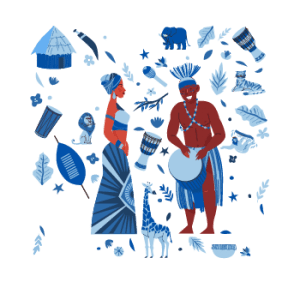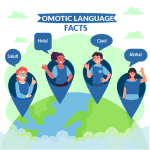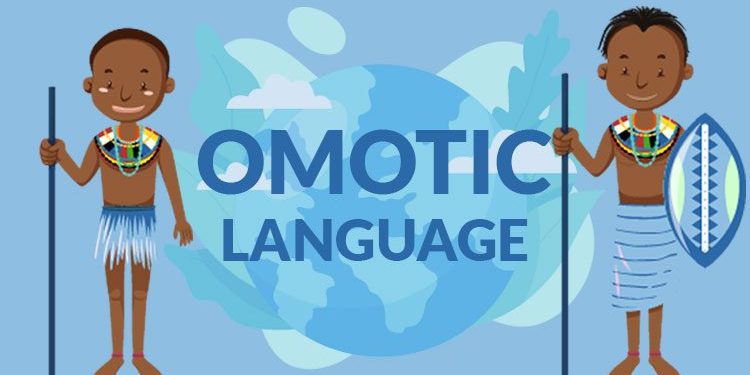Omotic languages
Omotic languages are spoken in the Horn of Africa, particularly among the ethnic minorities in Ethiopia, Kenya, and Somalia. While relatively few people speak them natively today, they have a fascinating history that stretches back thousands of years. Here are five interesting facts about Omotic languages that you might not know already!
South Omotic and West Cushitic are both independent branches within the larger Afroasiatic language family, with South Omotic belonging to the Omotic branch and West Cushitic constituting a distinct language within the western branch. South Cushitic and Chadic are divergent branches within Afroasiatic, with Chadic situated independently. The Omotic people, indigenous to the Omo Valley, are Omotic speakers, contributing to the linguistic diversity of this region.
M. Lionel’s research on the Afroasiatic phylum, documented in publications by AltaMira Press, explores linguistic connections, including the Proto-North Omotic language, among Afro-Asiatic speakers in regions spanning North Africa, Northeast Africa, West Africa, South Omo, and South Arabian, shedding light on the linguistic ties to Ancestral South Indian populations.
Ancient DNA analysis, including admixture and biogeographical analyses, has provided insights into the genetic relationships among Ethiosemitic speakers, Jewish individuals, and Afro-Asiatic-speaking populations, revealing connections to both ancient individuals and modern populations in regions ranging from Central Asia to East Asia, with specific attention to samples from Somalia and Neolithic populations.
Gideon Goldenberg’s research delves into the genetic history of people indigenous to the Chadic region within the Afroasiatic language family, utilizing admixture and biogeographical analyses, with a focus on the Somali sample and Neolithic samples, to unravel the intricate connections shaping the genetic landscape of this population.
1) They are at least 10,000 years old
According to research by Thomas Olander and co-authors, every Omotic language could have been derived from a proto-Omotic that existed somewhere between 10,000 and 20,000 years ago. This means all languages on that family tree may be much older than researchers once believed. It also means it’s nearly impossible to estimate how many speakers of each individual language exist today.
2) People speak them in six countries in Africa
Ethiopia, Eritrea, Kenya, Sudan, South Sudan, and Uganda. Many Ethiopian languages belong to the cushion language family. There are three main groups of them: northern, central, and southern. The Amharic language is a Semitic language closely related to Arabic spoken in Ethiopia and Eritrea.
It is one of six languages that belong to a subgroup of Semitic languages known as Afro-Asiatic which also includes many other Ethiopian languages such as Ancient Egyptian (which died out around 100 B.C.), Hebrew, Arabic and Maltese to name a few. Like consonant length, contrastive vowel length is a common feature of Ethiopian languages. In general, it is easy to identify a Cushitic, Omotic or Semitic language.

3) Ethiopia is the only country where they are spoken as official languages.
Although there are about 37 ethnic groups speaking over 100 different languages in Ethiopia, just two of these languages—Amharic and Tigrinya—are written, used by government officials, and taught to schoolchildren. But 6 other Ethio-Semitic languages are still spoken by large numbers of people throughout Ethiopia: Arabic (by Muslims), Gurage (in central Ethiopia), Oromo (in southern Ethiopia), Saho-Afar (also in southern Ethiopia), Sidamo and Somali. East Lansing: African Studies Center, Michigan State University.
4) People mainly use Cushitic, Oromo and Amharic for official purposes
Cushitic is spoken in various countries including Ethiopia, Somalia and Kenya; Oromo is primarily used in Ethiopia, but can also be heard in Tanzania and Kenya; Amharic is spoken by at least 10 million Ethiopians. Omotic languages are native to those who speak them but not considered official. Furthermore, these languages are only written down in syllabary form.
5) There are no major dialects of Omotic languages
While dialects of many languages around the world have been grouped into major language groups, such as Indo-European or Afro-Asiatic, there are no similar groupings in Africa. Instead, there are hundreds of independent languages that share a common history of development. Each of these languages is unique and fascinating!
Cushitic Languages
Cushitic languages form a branch of the Afro-Asiatic language family. They are spoken in Ethiopia, Eritrea, Somalia, Kenya, and Djibouti — countries located in the Horn of Africa. The dominant Cushitic languages, both in terms of the number of speakers and geographical extension, are Oromo, with about 24 million speakers in Ethiopia and Kenya; Somali, with 12.6 million speakers in Somalia, Ethiopia, and Djibouti; Sidamo with 1.9 million speakers in Ethiopia; Afar with about 1.4 million speakers in Eritrea; and Bedawi with about 1.2 million speakers in Sudan.
A widespread language family of the Hamitic branch within the Hamitosemitic language tribe, spoken by a total of more than 20 million people, mainly in the countries of Ethiopia, Eritrea, Djibouti, Somalia and partly Kenya and in the eastern part of the Republic of Sudan. They are divided into about 47 languages. Their speakers belong to the Ethiopian people and do not form a cultural unit. Even the individual languages sometimes differ so widely that not all scientists count them in the same group. For example, it is still relatively unclear whether the Omotic languages belong to the Cushitic languages at all.
Kushite Family of Peoples
The Kushite population in Kenya rarely exceeds half a million, or around 5% of the population. The nomadic Kushites, however, settled in a vast area of flat land that occupied nearly two-thirds of all of Kenya. They mainly belong to the Oromo , Somali , Omots and Gemu-Gofa group and consist of the tribes: Gurre, Ogaden, Degodiya, Orma, Gelubba, Kaffa, Gabbra, Borana, Rendille, Merille, Marechan, Chakorom, Schawiya, Gurlejo, Gosha, Adjuran, Murre, Abdwak, Abdulla and Aulichan.
The Kushite family of peoples, formerly known as the “East Hamites” , is linguistically related to both the Berbers and the Semitic peoples. The term “Kuschiten” was given to them in 1880 by the linguist KARL RICHARD LEPSIUS, who was born in Naumburg an der Saale, and introduced this term into scientific usage. He derived it from the biblical Cush, the son of Ham and grandson of Noah, who according to the genealogy of Genesis 10:6-7 is considered the progenitor of the peoples of this area.
The Cushitic peoples, and thus also their languages, are divided into southern, northern, central, western and eastern groups. Some tribes in the so-called zero-drain area of Tanzania are considered South Kushites, namely the Burungi (Mbulungu), Chasi (Alawa), Gorowa and others, all of whom are better known as Iraqu . These tribes are probably remnants of a population that was once much more widespread and could only survive in these retreat areas. The North Kushites, also isolated from the main mass, the Bedja with her “to behold”mentioned language, are mainly nomadic cattle breeders between the Nile and the Red Sea. They are mentioned in ancient Egyptian and other ancient sources, making them one of the oldest pastoral peoples in Africa.
Omotic Overview and Distribution
An omotic overview is a group of close to 30 languages, spoken by about six million people, in southwest Ethiopia around the river Omo. They constitute, according to many scholars, one of the six branches of the Afro-Asiatic phylum. Most Omotic overview languages have short words, many of them monosyllabic. Historical linguistics and genealogical language classification in Africa. Long periods of interaction with speakers of authentic African tone languages of Niger-Congo and Nilo-Saharan origin may therefore have aided the historical shift from pitch accent to tone systems in Afro-Asiatic.
How Many Languages Does Ethiopia Have?
In Ethiopia language is a fascinating topic. It’s one I’ve been exploring in detail recently, so writing about my findings seemed like a good way to share my linguistic journey. Ethiopia is the oldest independent country in Africa. It shares land borders with Somalia, Somaliland, Djibouti, Kenya, Eritrea, Sudan, and South Sudan, so many of its languages and dialects flow into and out of these countries. Other languages use common gender in the plural (i.e., there is no gender distinction in the plural).
In total, there are languages in Ethiopia, according to Ethnologue. 41 of those languages are classed as institutional, while 14 are developing and 18 vigorous. Ethiopia also has eight languages that are in danger of extinction and five that are close to it. The Ongota language spoken in southwest Ethiopia, for example, had just 12 elderly native speakers back in 2012, according to UNESCO (Ongota speakers have instead adopted the Tsamai language).

Oromo
Ethnologue’s 2021 data shows that Oromo has 37.4 million first language speakers. That means that it has more native speakers than any other Ethiopan language. It’s spoken as a first language by over 33% of the country’s population. Spoken widely across the Horn of Africa, Oromo is used as a lingua franca in Ethiopia and a language of primary education in several states.
This is despite Emperor Haile Selassie, who ruled Ethiopia from 1930 to 1974, banning Oromo’s use in education, administrative matters, and even in conversation. With human controllers, adjectives take the expected gender agreement, as do third-person verbal subjects. The tale doesn’t end there, because the prohibitive paradigm’s evolution suggests that the seemingly random syncretism of 2SG with 3SG feminine agreement may be reinterpreted as genuine gender marking, and realigned to fit the final verb’s gender-marking pattern. Michigan State University’s African Studies Center is located in East Lansing.
The foreign designation Galla or Galligna is considered outdated and is rejected by the Oromo. Oromo has been officially written with the Latin alphabet since 1991. Before that, the Ethiopian script was mainly used, although under the government of Haile Selassie it was forbidden to write Oromo at all. The Arabic alphabet was also used, and occasionally the Latin script (introduced by missionaries) in the 19th century, before the conquest of most of the Oromo areas by Ethiopia.
At least 99% of Oromo speakers live in Ethiopia, most of them in the Oromia (Oromiyaa) region, most of the rest in Kenya, but there are also about 42,000 speakers in Somalia. It is the language with the largest number of native speakers in Ethiopia (31.6%) and the fifth-largest in Africa. In addition to the native speakers, members of other ethnic groups who are in contact with the Oromo also speak this language.
The different variants of Oromo can be grouped into three main dialect groups:
* West-central Oromo
* Wollega (Wallagga) or Macha (Macca), spoken in north-west Oromia
* Tulama (Tuulamaa) or Shoa (Shawaa), spoken in north-central Oromia
* Wollo ( Wallo), spoken in the Wollo region, partly also in Amhara
* Raya (Raayyaa), spoken further north than the Wollo dialect

Amharic
The Amharic language is an Afroasiatic language and belongs to the subgroup of Semitic languages. The Semitic languages include Arabic, Hebrew, and Amharic, as well as the ancient languages of Assyro-Babylonian, Aramaic, Phoenician, and Moabite. Since the replacement of the ancient Ethiopian language (Ge’ez), Amharic has been the official language in Ethiopia and also the main language of communication in the neighboring countries.
The language is named after the Amhara people, who are native to northern Ethiopia. Amharic knows several dialects and regional variations. Mainly the dialects Gondar, Gojjam, Wollo and Shewa are distinguished. Since this language area has not been researched particularly well, it is assumed that there is a much larger number of dialects and a more complex breakdown of the Amharic languages. Amharic speakers are mostly found in Ethiopia’s north and northwest regions, as well as in Addis Ababa, the country’s capital.
As already mentioned, the official language in Ethiopia is Amharic and is spoken by around 17 million speakers as their mother tongue and another four million as a second language. However, the language with the most speakers in Ethiopia is Cushitic Oromo with about 25 million native speakers. English is used in Ethiopia as the language of education and as the language of instruction in high schools. In the border areas, however, in some states, regional languages are also used, at least in elementary schools and in local government.
The Amharic language was only a relatively insignificant folk dialect in southern Ethiopia until the 14th century and only gained importance with the transfer of the royal residence to this area. Originally, Amharic was only passed on orally. After Ancient Ethiopian died out, the Ge’ez script used there was transferred to Amharic and modified. While Amharic is a Semitic language, it is written left-to-right and is a true syllabic language. The vowels are represented by small suffixes to the consonants. The pronunciation of Amharic also differs from the other Semitic languages.
Ongota
The Ongota language spoken in southwest Ethiopia, for example, had just 12 elderly native speakers back in 2012, according to UNESCO (Ongota speakers have instead adopted the Tsamai language). That means that it has more native speakers than any other Ethiopan language. Another language in Ethiopia to have gained official status in 2020, Tigrinya (or Tigrigna) is a northern Ethiopia language with around 6.4 million native speakers. Gedeo has around 980,000 native speakers.

Ongota Language
The Ongota language was classified as endangered. Only 6 people speak it, and all of them are elderly. The language is in a critical position. However, unlike the situation with many other endangered languages, there is even a professor at Addis Ababa University in Ethiopia who studies the language. He came to the conclusion that language adheres to the “subject, object, verb” structure. Ongota is an Afro-Asiatic language spoken in a tiny village on the east coast of the Weito River in Ethiopia. Historical linguistics and genealogical language classification in Africa.
Morphology and grammar
Traces of gender and case marking in the noun do not easily relate to common Afro-Asiatic morphemes (such as -b/-o for masculine and -n/-a for feminine). The pronouns, which have largely lost masculine and feminine gender distinction, are quite different from those of Cushitic but nevertheless show affinities with Afro-Asiatic. Subject pronouns can occur as prefixes, suffixes, or both, and some Omotic languages have replaced affixes with independent pronouns.
Phonetics and phonology
If Omotic languages are genealogically related to Proto-Afro-Asiatic, they have undergone a remarkable reduction of the characteristic phonological inventory. For example, although Omotic languages have glottalization, as do most Afro-Asiatic languages, they do not have the pharyngeal consonants that are common among the other members of that phylum.
Omotic languages also have a marked reduction in the phonological material of words compared with other Afro-Asiatic languages. That is, they tend to be much shorter with regard to numbers of consonants and vowels, a situation that renders morphological comparisons within the phylum difficult. Because of the high frequency of monosyllabic words, many Omotic languages use tonal distinctions to bear a considerable functional load in conveying the meaning of a word. However, not all Omotic languages are necessarily tonal; some, such as Koyra, appear to have a pitch accent system instead.
- East Lansing, Michigan: African Studies Center, Michigan State University.Gray, James & Tina Gregor. 2019.
- East Lansing: African Studies Center, Michigan State University.
- Austin & Andrew Simpson (eds), Endangered languages (Linguistische Berichte 14), 143–172.
- Leiden: Research School of Asian, African and Amerindian Studies, Leiden University.Amha, Azeb. 2012.
- In Bender, M. L. (ed.), The non-Semitic languages of Ethiopia, pp. 298–323. (Monograph No. 5, Occasional Papers Series, Committee on Ethiopian Studies 1).Oxford: Oxford University Press.Treis, Yvonne. 2014.
- Dryer & Martin Haspelmath (eds) The world atlas of language structures online.
- Leiden: Leiden University dissertation.
- In Ronny Meyer, Yvonne Treis & Azeb Amha (eds), Explorations in Ethiopian linguistics: Complex predicates, finiteness and interrogativity, 41–78.
- John Benjamins Publishing.Research in Afroasiatic Grammar TwoISBN978-90-272-4753-7.
- Afrikanistische Arbeitspapiere. (Special issue on North-East Africa linguistic and literary studies) 65: 157–67.
- Lionel Bender (ed.), The Non-Semitic languages of Ethiopia, 298–323.
- Adams, B. A. 1983. A Tagmemic analysis of the Wolaitta language. PhD thesis, School of Oriental and African Studies, University of London.
- School of Oriental and African Studies.Hayward, Richard J. 2003.
- University of Tokyo dissertation.Wheeler, Alva. 1987.
- East Lansing, Michigan: African Studies Center, Michigan State University.Gray, James & Tina Gregor. 2019.
Frequently Asked Questions
Although Amharic is the government’s official language and a widely spoken lingua franca, just 29% of the people reported speaking it as their first language in 2007. Over a third of Ethiopia’s population speaks Oromo as their native language, making it the country’s most frequently spoken primary language.
A former name for the Afro-Asiatic family of languages is called non-Semitic languages.
No, Oromo is a Semitic language, and comes in right behind Arabic as the most spoken Semitic language.
An assertive forms of a sentence is a sentence that states a fact. Such sentences are simple statements. They state, assert, or declare something. They are also called declarative sentences. Assertive sentences usually end with a period or full stop.
Genealogical language classification
Language families are formed based on diachronic relatedness. In other words, individual languages are classified into families depending on how they formed and changed over time, with languages descended from a common ancestor being grouped together.
An endangered language is one that is on the verge of becoming extinct. Many languages are fading from usage and being supplanted by more frequently spoken individual languages in the region or country, such as English in the United States or Spanish in Mexico. These endangered languages will become extinct within the next century unless present trends are reversed.
The term “dialect” refers to a group of closely related languages, while the term “variety” refers to a language that has been influenced by another language.








